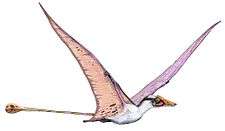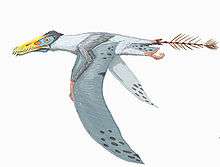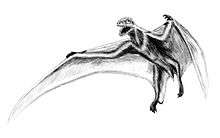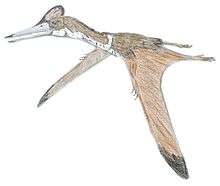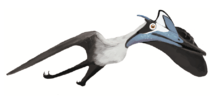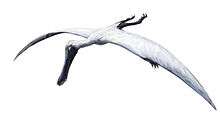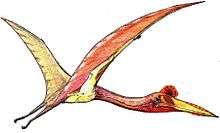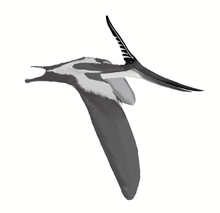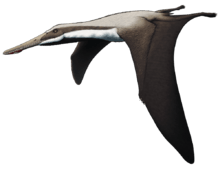Jidapterus
Jidapterus is a genus of azhdarchoid pterodactyloid pterosaur from the Aptian-age Lower Cretaceous Jiufotang Formation of Chaoyang, Liaoning, China. The genus was in 2003 named by Dong Zhiming, Sun Yue-Wu and Wu Shao-Yuan. The type species is Jidapterus edentus. The genus name is derived from Jílín Dàxué or "Jilin University" and a Latinised Greek pteron, "wing". The specific name means "toothless" in Latin.
| Jidapterus | |
|---|---|
| Holotype specimen RCPS-030366CY | |
| Scientific classification | |
| Kingdom: | Animalia |
| Phylum: | Chordata |
| Order: | †Pterosauria |
| Suborder: | †Pterodactyloidea |
| Family: | †Chaoyangopteridae |
| Genus: | †Jidapterus Dong, Sun & Wu, 2003 |
| Species: | †J. edentus |
| Binomial name | |
| †Jidapterus edentus Dong, Sun & Wu, 2003 | |
The genus is based on holotype CAD-01, a nearly complete skeleton with partial skull. The skull is toothless and relatively long, with a straight and very pointed beak, and a large hole where the antorbital fenestra is joined with the nostrils. The eye sockets are small, and there is no crest along the lower jaw as seen in ornithocheiroids, although a short projection was present at the back of the skull. The wingspan of this individual was estimated to be 1.7 m (5.58 ft).[1] Its classification has been unstable; the original authors did not assign it to a group.[2] Some of the original authors later suggested it was a more basal azhdarchoid,[3] whereas another group suggested it was closer to Pteranodon and possibly the same genus as Chaoyangopterus.[4] David Unwin assigned it to Tapejaridae without comment in The Pterosaurs: From Deep Time,[5] but later, in a collaboration with Lü, agreed that it belonged to another azhdarchoid group and was a close relative of Chaoyangopterus, placing both in the new family Chaoyangopteridae.[6] A redescription of the genus in 2017 corroborated these results, and also presented evidence distinguishing it from Chaoyangopterus.[7]
Classification
Below is a cladogram showing the phylogenetic placement of Jidapterus within Neoazhdarchia from Andres and Myers (2013).[8]
| Neoazhdarchia |
| |||||||||||||||||||||||||||||||||||||||||||||||||||||||||||||||||||||||||||||||||||||||||||||||||||
References
- Dong, Z.; Sun, Y.; Wu, S. (2003). "On a new pterosaur from the Lower Cretaceous of Chaoyang Basin, Western Liaoning, China". Global Geology. 22 (1): 1–7.
- Li, J.; Lü, J.; Zhang, B. (2003). "A new Lower Cretaceous sinopterid pterosaur from the Western Liaoning, China". Acta Palaeontologica Sinica. 42 (3): 442–447.
- Lü, J.; Ji, Q. (2006). "Preliminary results of a phylogenetic analysis of the pterosaurs from western Liaoning and surrounding area" (PDF). Journal of the Paleontological Society of Korea. 22 (1): 239–261.
- Xiaolin Wang, Kellner; Zhou, Zhonghe; de Almeida Campos, D. (2005). "Pterosaur diversity and faunal turnover in Cretaceous terrestrial ecosystems in China". Nature. 437: 875–879.
- Unwin, D.M. (2006). The Pterosaurs: From Deep Time. Pi Press:New York, p. 273. ISBN 0-13-146308-X.
- Lü, J., Unwin, D.M., Xu, L., and Zhang, X. (2008). "A new azhdarchoid pterosaur from the Lower Cretaceous of China and its implications for pterosaur phylogeny and evolution." Naturwissenschaften
- Wu, W.-H.; Zhou, C.-F.; Andres, B. (2017). "The toothless pterosaur Jidapterus edentus (Pterodactyloidea: Azhdarchoidea) from the Early Cretaceous Jehol Biota and its paleoecological implications". PLoS ONE. 12 (9): e0185486. doi:10.1371/journal.pone.0185486. PMC 5614613. PMID 28950013.
- Andres, B.; Myers, T. S. (2013). "Lone Star Pterosaurs". Earth and Environmental Science Transactions of the Royal Society of Edinburgh: 1. doi:10.1017/S1755691013000303.
